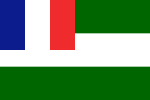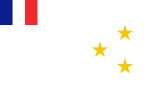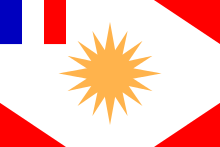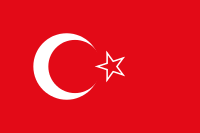As a result of the ongoing Syrian civil war, there are currently two governments claiming to be the de jure government of Syria, using different flags to represent the state. The incumbent government, led by Bashar al-Assad and the Ba'ath Party, is using the red-white-black United Arab Republic flag in use since 1980; while the Syrian Interim Government, led by the Syrian National Coalition – seeking to overthrow the Assad government – readopted the green-white-black Independence flag in 2012.
Flag used by the Assad government
Syrian Arab Republic |
 |
| Use |
National flag and ensign |
|---|
| Proportion |
2:3 |
|---|
| Adopted |
22 February 1958, abandoned on 28 September 1961; readopted on 30 March 1980[1] |
|---|
| Design |
A horizontal tricolour of red, white, and black; charged with two green stars at the centre. |
|---|
The current flag was first adopted in 1958 to represent Syria as part of the United Arab Republic, and was used until 1961. It was readopted in 1980. Since its first adoption, variations of the red-white-black flag have been used in various Arab Unions of Syria with Egypt, Libya, Sudan, Yemen and Iraq. Although Syria is not part of any Arab state union, the flag of the United Arab Republic was readopted to show Syria's commitment to Arab unity.[2] The usage of the flag has become disputed because it is often associated with the Ba'ath Party and has come to represent parties loyal to Assad's government in the Syrian civil war.[3]
The Syrian flag is described in Article 6 of the Syrian Constitution. The first paragraph of the Article states:
The flag of the Syrian Arab Republic consists of three colours: red, white and black, with two green stars, of five angles each. The flag is rectangular, with its width measuring two thirds of its length. It is divided into three rectangles of identical dimensions and have the same length as the flag. The upper one is red, the middle being white and the bottom one is black, with the two green stars in the middle of the white rectangle.
Flag used by the Syrian National Coalition and Syrian Interim Government
Syrian National Coalition
Syrian Interim Government |
 |
| Name |
"Independence flag"[5] |
|---|
| Use |
National flag and ensign |
|---|
| Proportion |
2:3 |
|---|
| Adopted |
Originally in 1932 with 1:2 aspect ratio, was readopted in 1961. Adopted with 2:3 aspect ratio in 2012 by opposition government-in-exile[6] (sometimes the original 1:2 aspect ratio flag is used unofficially) |
|---|
| Design |
A horizontal tricolor triband of green, white, and black, with three red stars charged in the center. |
|---|
During the ongoing revolution, the Syrian opposition, represented by the Syrian National Council, then by the National Coalition for Syrian Revolutionary and Opposition Forces[7] (commonly named the Syrian National Coalition) used a modified version of the independence flag first used in 1932 with a 2:3 aspect ratio. The modified independence flag began to be used as a universal display of the protesting opposition in late 2011.[7] The opposition wanted to distinguish themselves from the current Syrian government and favoured the use of the flag used when Syria gained its independence from France. Khaled Kamal, an official from the Syrian National Council, now believes this flag to also represent independence and the end of Bashar al-Assad's government. Today the flag is mainly used in areas controlled by the Syrian National Coalition. The use of the modified independence flag is similar to the Libyan rebels' use of the pre-Gaddafi Libyan flag from the era of the Kingdom of Libya in opposition to Muammar Gaddafi's green flag.[8] The original 1:2 aspect ratio flag has been used by the opposition unofficially on several occasions.
Historic flags of Syria
Kingdom of Syria (1920)
The first native Syrian flag was that of the short-lived Kingdom of Syria. The Ottoman flag had been used in Syria until Ottomans left the country on 18 September 1918. In 1918, the official flag of Syria was the Faysal flag, the flag of the Arab revolt between 1916 and 1918. It was officially adopted by the Hashemite family on 30 September 1918 and remained in use until 8 March 1920. The Faysal flag was then redesigned with the 7-pointed white star and was in use until 24 July 1920. This flag was, however, was adopted by Jordan somewhat later.[2] The kingdom lasted for just over 4 months in 1920 before being occupied by France and formally incorporated into the French colonial empire for some 12 years. Due first to French stalling with regard to signing an independence treaty, then followed by the chaotic political environment of World War II, Syria continued to be factually occupied to varying degrees. The last French troops left Syria in August 1946.
French Mandate flags (1920–32)
The Faysal flag was abandoned with the arrival of French colonials to Syria. The French High Commissioner for Syria, General Henri Gouraud adopted the new flag of the French Mandate of Syria (blue with a white crescent, see below) on 24 July 1920. Gouraud's flag was in use until 1 September 1920, after which Syria was split into separate territories, each eventually given its own flag.[11] The Prime Minister of Syria under French Mandate, Jamil al-Ulshi, adopted the new flag on 22 June 1920. This flag was in use until 1930. The third and final flag under the French Mandate was adopted by Prime Minister Taj al-Din al-Hasani in 1930 and was used until 1 January 1932.[12]
Independence flag
French Mandate and independence (1932–58, 1961–63)
The flag of the newly established Syrian Republic, under the French mandate was determined by the 1930 constitution. The constitution was drafted by a parliamentary committee led by nationalist leader Ibrahim Hananu. At first, French authorities refused to allow the constituent assembly to ratify the constitution, and Henri Ponsot, the High Commissioner of the Levant, dissolved the assembly on 5 February 1929. After a public uproar, French authorities rescinded their decision and decided to approve the draft with some changes. On 14 May 1930, Ponsot issued decree number 3111, which approved the Syrian-drafted "Constitution of the Syrian Republic", and which in Article IV of Part I states:
"[The] Syrian flag will be as follows: length double width, and is divided into three parallel and equal colors, the highest green, white then black, that the white section contains in a straight line three red five-pointed stars".— Article IV, Part I, Constitution of the Syrian Republic[15]
The flag was adopted when Syria gained its independence on 17 April 1946.[2] The flag's green colour stood for the Rashidun, white represented the Umayyads and black symbolised the Abbasids. Originally, the three red stars represented the three districts of Syria, Aleppo, Damascus, and Deir ez-Zor. In 1936, the Sanjak of Latakia and Jebel Druze were added to Syria, and the representation of the three stars was changed, with the first representing the districts of Aleppo, Damascus and Deir ez-Zor, the second Jebel Druze, and the final star representing Sanjak of Latakia.[12] The flag was officially hoisted in Damascus on 11 June 1932, but was previously flown in Aleppo on 1 January 1932.[12] The flag was used as a symbol for Syrians to rally around when France reneged on its agreement to leave the country, due to the outbreak of World War II. The standard was used until the creation of the United Arab Republic, a state union of Syria and Egypt, in 1958. After the collapse of the United Arab Republic, Syria used the UAR's flag until 28 September 1961, when it was replaced by the independence flag to disassociate Syria from the former failed union.[2]
Ba'athist flags
Flag of Syria between 1963 and 1972 and
Flag of Iraq between 1963 and 1991
The current two-star flag of Syria was first adopted by Gamal Abd al-Nasser, president of Egypt and president of the United Arab Republic. The flag was changed from the former independence flag in April 1958 along with associated laws designed to create a greater Arab identity. The new flag took the coloured red-white-black bands from the Arab Liberation flag and the stars on the flag were changed from red to green in order to restore the pan-Arab colours. The two stars represented Egypt and Syria.[18] After Syria left the UAR on 28 September 1961, the previous independence flag was readopted to disassociate Syria from the failed union. The first flag of Syria to be adopted by its Revolutionary Command Council — following a Ba'athist coup d'état — was adopted on 8 March 1963, and was used until 1 January 1972.[2] In 1963, the Ba'athist regime came to power in Iraq as well, and the two Ba'athis governments began negotiations in Cairo in order to once again form a union between Egypt, Syria and Iraq. The process failed after the Iraqi Ba'athist government was overthrown in November 1963 but both Syria and Iraq did adopt a new flag to represent the union. This flag was not much different from the flag of the UAR, with only a change from two stars to three, in order to represent the addition of Iraq to the Federation.[2] The three stars represented the unity of Egypt, Syria and Iraq, as well as three pillars of Ba'athism: unity, freedom, and socialism.[21] President Hafez al-Assad adopted the new flag on 1 January 1972, as Syria joined Egypt and Libya in the Federation of Arab Republics. The green stars were replaced by the Hawk of Quraish (the symbol of the tribe of the Prophet Muhammad). The eagle held the ribbon with name of the Federation, but unlike Egypt and Libya, Syria did not include its name on the coat of arms.[12] This flag was an official flag during the October War in 1973.[2] The Federation was dissolved in 1977, but Syria continued to use the flag for the next three years.[12] The flag was abrogated on 29 March 1980,[2] and replaced by the current two-star flag[21] in order to show Syria's commitment to Arab unity.[2]
List of flags of Syria
|
|
 |
| 1922–1932, Syrian Federation and State of Syria |
|
|
|
.svg.png) |
| 1961–1963, Syrian Arab Republic |
|
%3B_Flag_of_Syria_(1963-1972).svg.png) |
| 1963–1972, Syrian Arab Republic |
|
|
|
 |
| 1980–present, Syrian Arab Republic |
|
Flags of heads of state
.svg.png) |
| 1920, Royal Standard of the King of Syria |
|
.svg.png) |
| 1972–1980, Standard of the President of Syria |
|
 |
| 1980–present, Standard of the President of Syria |
|
Other opposition flags used in Syrian Civil War
 |
| 2011-present, Makeshift version of the Syria Independence flag used by protesters |
|
.svg.png) |
| 2011-present, Original Syria Independence flag, unofficially used by protesters |
|
Mandate of Syria
Each of the states in the French Mandate of Syria had its own distinct flag. The Alexandretta Sanjak, which was a part of Aleppo State from 1920 to 1923, and later a part of the Alawite State from 1923 to 1938, did not have its own flag until it became independent as the Hatay State.
|
|
|
|
.svg.png) |
| 1924–1936, State of Souaida and Jebel Druze State |
|
|
|
See also
References
- ↑ Ipavec, Eugene (17 March 2012). "Syria". Flags of the World. Retrieved 7 August 2012.
- 1 2 3 4 5 6 7 8 9 "Syrian Flag". History of Syria. Retrieved 7 August 2012.
- ↑ Moubayed, Sami (6 August 2012). "Capture the Flag". Foreign Policy. Retrieved 8 October 2014.
- ↑ "English Translation of the Syrian Constitution". Qordoba. 15 February 2012. p. 8. Retrieved 14 November 2012.
- ↑ http://www.ft.com/cms/s/0/6c332676-32f4-11e1-8e0d-00144feabdc0.html#axzz21nLTtBKA
- ↑ http://www.etilaf.org/
- 1 2 "Syria halts Homs siege as Arab monitors arrive". CBS News. 27 December 2011. Retrieved 30 August 2012.
- ↑ Daraghi, Borzou (30 December 2011). "Syrian rebels raise a flag from the past". Retrieved 7 August 2012.
- ↑ Sache, Ivan; Ollé, Jaume (29 March 2012). "Historical Flags Until 1932 (Syria)". Flags of the World. Retrieved 22 November 2012.
- 1 2 3 4 5 Ipavec, Eugene; Martins, António; Heimer, Željko; Dotor, Santiago (10 June 2011). "Historical flags since 1932". Flags of the World. Retrieved 7 August 2012.
- ↑ The 1930 Constitution is integrally reproduced in: Giannini, A. (1931). "Le costituzioni degli stati del vicino oriente" (in French). Istituto per l’Oriente. Retrieved 31 March 2012.
- ↑ Mills, T. F. (10 March 2012). "Pan-Arab Colours". Flags of the World. Retrieved 24 November 2012.
- 1 2 العلم السوري (in Arabic). Discover Syria. Retrieved 7 September 2012.
Bibliography
- Goodarzi, Jubin M. (2006). Syria and Iran: Diplomatic Alliance and Power Politics in the Middle East. I.B. Tauris. ISBN 9781845111274.
- Heydemann, Steven (1999). Authoritarianism in Syria: Institutions and Social Conflict, 1946–1970. Cornell University Press. ISBN 9780801429323.
- Lawson, Fred H. (2006). Constructing International Relations in the Arab World. Stanford University Press. ISBN 9780804753722.
- King, Stephen J. (2009). The New Authoritarianism in the Middle East and North Africa. Indiana University Press. ISBN 9780253353979.
- Podeh, Elie (1999). The Decline of Arab Unity: The Rise and Fall of the United Arabic Republic. Sussex Academic Press. ISBN 9781902210209.
- Schumann, Cristoph (2008). Liberal Thought in the Eastern Mediterranean: Late 19th Century Until the 1960s. BRILL. ISBN 9789004165489.
- Thomas, Martin (2007). Empires of Intelligence: Security Services and Colonial Disorder after 1914. University of California Press. ISBN 9780520251175.
- Thompson, Elizabeth (2000). Colonial Citizens: Republican Rights, Paternal Privilege, and Gender in French Syria and Lebanon. Columbia University Press. ISBN 9780231106610.
|
|---|
|
| |
|
- 1 Arab League member; partially recognized internationally
|
|
|---|
|
| National flags | |
|---|
|
| National coats of arms | |
|---|


.svg.png)

.svg.png)

%3B_Flag_of_Syria_(1963-1972).svg.png)
.svg.png)
.svg.png)
.svg.png)
.svg.png)





.svg.png)
.svg.png)
.svg.png)

